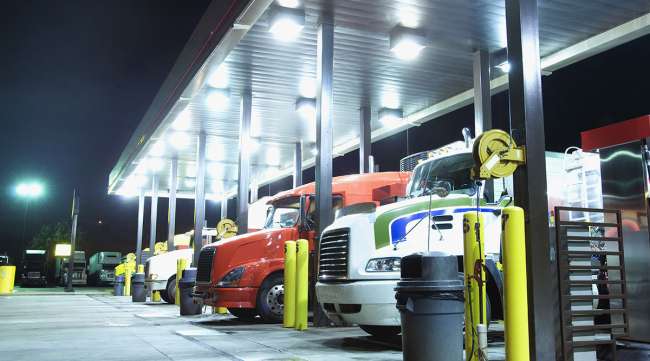Staff Reporter
NCDOT Considering Technology, More Truck Stops to Ease Parking Shortage

North Carolina’s Department of Transportation is exploring construction of additional truck stops and installation of sensor technology to resolve its shortage of truck parking spaces.
According to NCDOT’s “North Carolina Truck Parking Study,” which was published in February, truck parking is the third most pressing issue facing truck drivers in the state. The study reveals that 87% of drivers spend at least 30 minutes trying to find parking along North Carolina’s interstates.
NCDOT is a member of the I-95 Corridor Coalition, a partnership of transportation departments and toll authorities that represents every state Interstate 95 touches, from Maine to Florida. The coalition serves as a forum for its members to collaborate on transportation issues.
The coalition participated in a Federal Highway Administration-funded program to test technology that collects information on truck parking availability. Such technology includes pavement sensors and cameras, according to Marygrace Parker, the I-95 Corridor Coalition’s freight, mobility, safety and security coordinator. The coalition’s portion of the study tested two sensor systems in Maryland and Virginia. “There’s not any one prescribed way that you can decide a trucker wants to get their information,” Parker said. “That’s an important lesson to share with other states along the corridor, including North Carolina.”
Parker said the coalition will share lessons learned from the pilot program with its members this spring.
Charles Edwards, director of logistics and strategic planning for NCDOT, said his department will participate in this review. NCDOT may also form partnerships to build more parking spaces in addition to investing in technology that signals their availability, he said.
Edwards noted that NCDOT has received inquiries from truck stop developers to create more stops along Interstate 95 and U.S. Route 74, which leads out of the Port of Wilmington. According to NCDOT, there are 600,000 truck moves related to container vessel operations at Wilmington every year. The study also states that 8,750 trucks move through I-95’s 30-mile corridor between Kenly and Benson every day.
The North Carolina Trucking Association requested that the state Legislature commission the study in December. Crystal Collins, president of the association, said she approached North Carolina’s secretary of state three years ago to discuss the lack of truck parking, particularly on Interstate 77, a north-south freight route that spans from Cleveland to Columbia, S.C.
“We have some truck parking issues where there’s no place for trucks to stop except on on-ramps and off-ramps. It’s more than just that area. It’s a nationwide issue,” Collins said. “The truck parking study was to look at how we can fund truck parking.”
With the help of the American Transportation Research Institute, NCDOT collected data from hundreds of people, including drivers, truck stop operators and highway patrol officers.
NCDOT found that there are 4,783 truck parking spaces in the state. Some 4,064 of these spaces are privately owned, meaning they are attached to a truck stop or a Wal-Mart store. Edwards said some truck stop operators charge drivers a reservation fee, which is negotiated by trucking companies on the basis of their fuel contracts.
“There was a need to collect the information,” Edwards said. “Our study basically said it’s a recurring problem for drivers in the state, not that other states are immune.”
Drivers for Old Dominion Freight Line mostly encounter difficulty finding parking when they need to stop for meals and rest breaks, rather than overnight stays, said Sam Faucette, the carrier’s vice president of safety compliance. Old Dominion operates 15 distribution centers across North Carolina. This includes both local drivers to run pickups and deliveries as well as linehaul drivers, who make 500- to 600-mile trips.
“Don’t wait until the last minute to plan that mandatory stop. That’s what we’ve learned,” Faucette said. “The driver has to plan ahead. If his first two or three options aren’t available, plan a backup location to take that break.”
Edwards said he believes larger fleets will be better suited to use truck parking applications because many of them already have the necessary technological infrastructure.
“The operators with a small number of trucks don’t necessarily have all of that technology. They’re the ones, I would bet, that when they’re time is ticking down, they’re looking for a place to rest,” Edwards said.




